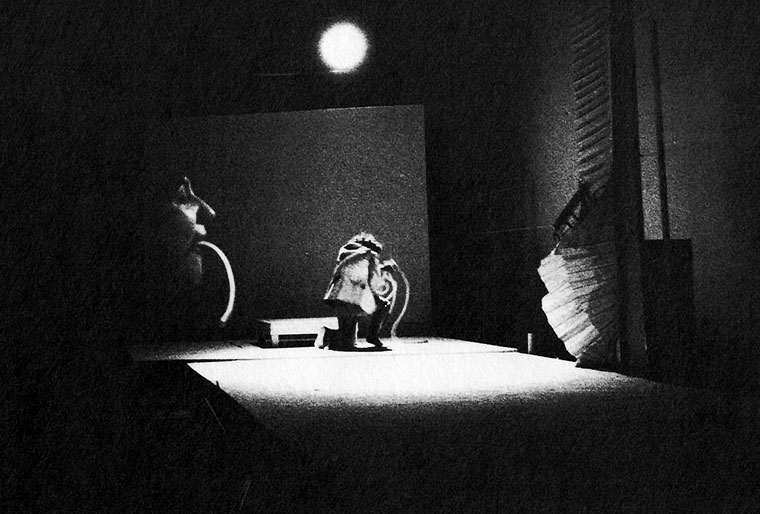duration: 60 ‘
a performance by Altro – Intercode working group
Alberto Bardi, Luciana Bergamini, Renato Brandi, Mario Bizzarri, Luigi CeccareUi, Graziella Conversi, Domenico Gozzupoli, Stefano Gagliardini, Alessandra Gianfranceschi, Pasquale De Antónis, Lucia Latour, Mai Ann Leong, Bruno Magno, Luciano Martinis, Romano Martinis, Isabella Montezemolo, Margherita Pace, Achille Perilli, Italo Piattelli, Marina Poggi, Enrico Pulsoni, Francesca Romana Sestili, Gaetano Trusso, Catherine Verwilghen.
Voices of
Kadigia Bove, Francesca Furlanetto, Eugenio Giordani, Luciano Martinis, Michela Mollia, Achille Perilli, Marina Poggi, Enrico Pulsoni, Giovanni Puma, Kerstin Riemer, Claudio Rufa, Stefano Scodanibbio, Gaetano Trusso, Catherine Verwilgen.
representations of the theatrical version
Mar 14 – 19, 1979 – Rome, Palazzo delle Esposizioni
Mar 25, 1979 – Warsaw (Poland), Stodola
Dec 03, 1979 – Rome, Palazzo delle Esposizioni
In 1980 of “Abominable A” was released a version for magnetic tape lasting 25 minutes.
The sound part of “Abonminable A” was made at the LEMS (Electronic Laboratory for Experimental Music) of the “G. Rossini” Conservatory of Pesaro between 1978 and 1980.
representations of the version for magnetic tape only
Apr 25, 1980 -Florence, Musica Ex Machina, Vanni room
June 7, 1980 – Bourges, France, Festival International des Musiques Experimentales.
1980 Rome, National Gallery of Modern Art, Musica Verticale Festival
Sep 1st 1980, Cesenatico, former Fish Market hall


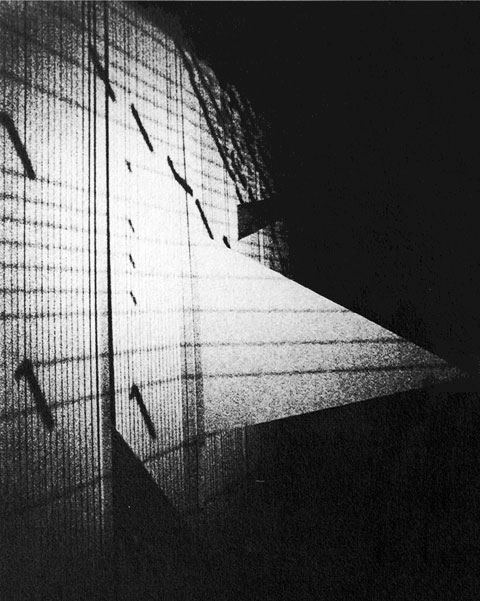
“ABOMINABLE A” is the fifth performance of the GRUPPO ALTRO, based like the previous ones on the problem of the intercode. «Intercode work does not simply mean superimposition or juxtaposition of interventions (albeit group) in the various codes. As a rule, when the codes overlap, it happens that they cancel each other out or struggle to prevail: but they do not lose specificity. Instead, by working intercode, specificity must be lost and the individual codes must end up being destroyed as isolated languages, dismantling the illusion of their autonomy and getting closer and closer to the real functioning of the mind. In fact, the mind works “intercode” from birth and the isolation of specific individuals codes is an artificial operation “.
“ABOMINABLE A” is a theatrical operation based on the 600 words that make up the letter a in Italian vocabularies, there are also arbitrary additions of foreign words with the same initial. These words in sequence are analyzed through a number of CREATIVE INTERCODE CATEGORIES:
analytical abstraction, abstract grotesque, machinerie, tale, ambiguity, repetition, banalitaten.
These creative intercode categories used as filters of elementary cataloging have provided a quantity of materials that are the starting point for theatrical moments, which starting from the meaning of the words themselves develop into a series of actions that they involve in their development different linguistic codes, superimposed in coinciding and opposite spaces.

The duration of the action is determined by the reading time.
In this particular experience of the ALTRO GROUP, two components are decisive for the construction of the stage structure: the sound that marks the time and the use of the cinematographic technique that continuously moves the plane from two to three dimensions.
The actions and characters that follow one another in the show are distinguished in order by the following words, a cue and pretext for the creation of visual or narrative nodes:
ABBECEDARIO, ABITUDINARIO, ABBIGLIAMENTO, MADAME ABOMINABLE, ACCORGERSI, MONSIEUR ALIBI, MONSIEUR ABSTRACTEUR, MADAME ACCROCHECOEUR, ACULE’, AERIEN, AFFIORARE, ALLINEAMENTO, ALMOHADA, ALTER EGO, AMORE, ACINESI, AREA, ATTORCERE, AZURINE.
The plastic elements are composed with each other, from time to time, in different ways, transforming themselves into costumes or spatial structures or containers of images: determining continuous variations of the scenic space with a constant exchange of functions and situations. The work of elaboration and creation of the various sequences is a group.
Gruppo Altro/Lavoro intercodice 1972-1981
It was founded in 1972, made up of painters, musicians, dancers, architects, graphic designers, photographers, who have worked collectively with a methodology they define as “intercode”. Based on this hypothesis, they have created exhibitions, didactic experiments, theatrical performances: where the theater is intended as the verification in a stage space of an inter-code operation that is proposed as a new linguistic possibility.
The hypothesis of the ALTRO Group was to declare the crisis of individual codes and possible interdisciplinarity, to propose instead a complex research on the inter-code possibilities of creative doing. Among the group’s achievements: “Altro / Gesto lavoro intercodice” (1973), “Altro / Merz, show-show by / by Kurt Schwitters” (1973-74), “Altro / Experimenta” (1974-75), “Altro / Didactic Method “(1975),” Other / Zaum structure / action “,” Other / June, space for political communication “(1976),” Other / Ics unknown of theatrical forms “(1977),” Altro / Abominable A ” (1979).
The headquarters of the group was in Rome, Vicolo del Fico 3.
The experience of the Gruppo Altro ended in 1981 with the publication of the book, “ALTRO – Ten years of intercode work” (Kappa Editions)
On the making of sound
The starting material from which the sound elements of Abominable A are obtained is obtained by recording on magnetic tape some voices that read all the words starting with A in the Italian language according to the order of the vocabulary. Also added are some words, always starting with A, of the French, English, German, Spanish, Czech language.
The recording took place by having about twenty different people read, very long sequences without interruption. A particular reading rhythm was required to each of them, in order to obtain that each sequence was rhythmically different, but except for the word “Abominable”, a particular diction character was never required.
The sound events are produced by a four-track magnetic tape. Some parts are exceptions:
«Anagramma» (I part) where nine actors perform live the score of a dialogue
«Alibi», also performed live by the actor.
Some sound moments of «Attorcere» are obtained by amplifying the sound of the metal structure shaken by the actors.
The sound diffusion system consists of six loudspeakers, four of which are fixed and two are mobile. The arrangement allows for two different acoustic spaces.
1 – the system consisting of the four fixed loudspeakers, placed behind the platform and behind the projection screens, determines a sound space corresponding to the visual space, that is to say “in front” of the spectators and along the entire platform. By modulating the four outputs of the recorder in amplitude, it was possible to simulate the movement of the sound along the platform.
2 – the listening system composed of the two mobile loudspeakers is not common to the field of visual actions, but completely independent, so that the sound space has no visual correspondence. In this case the sound comes from “above” the spectators. The movement of the sound is real, as the loudspeakers, driven by a system of pulleys, move parallel and independently along the entire audience.
The total time for carrying out the actions is determined approximately by the length of the list starting with the word “A” and ending with “Azurine”. Each different visual action corresponds to a different processing of the sound material. The relationship between the two fields, however, is never of correspondence, nor is there a relationship of subordination between them. The two components, sound and visual, proceed by influencing each other, so that the resultant is a single structure given by the
sum of all the sound and visual events.
The main parameters of sound processing are: rhythm, timbre, movement, position in space.
I – Rhythm
Each action corresponds to a particular elaboration of the rhythm, of which two types have been considered: the characteristic of the starting material, that is the rhythm of the diction, and the elaboration of this by means of laboratory techniques. Some words have been isolated or even fragmented, in order to obtain single rhythmic cells, then assembled randomly or according to precise rhythmic criteria. Also, in some cases several sequences were superimposed or even a sequence was superimposed on itself.
This made it possible to obtain a more complex rhythmic structure up to practically a continuous sound.
– Timbre
In addition to the tonal characterization of the different reciting voices, some words were electronically processed by means of filters, modulators and by varying the speed of the tape. Such modifications, in general, do not compromise comprehensibility; only in “Almohada”, the voices are processed in such a way as to be incomprehensible.
– Movement
As for the rhythm, the movement in space does not follow the movements of the visual actions along the platform and does not correspond to this, but the two elements combine with each other, so as to originate a system of complex and continuously variable relationships (eg. alignment score). In this way one never has the supremacy of one perception system over the other; even when one of the two components is very elementary, its contrast with the other significantly affects the perceptual effect, helping to modify the resulting structure.
– Space
By means of the two diffusion systems it was possible to obtain a spatial distribution of the sound elements that is continuously varying
bile. A particular type of reverberation has been added to each sound, to give a feeling of different distance from the sound sources.
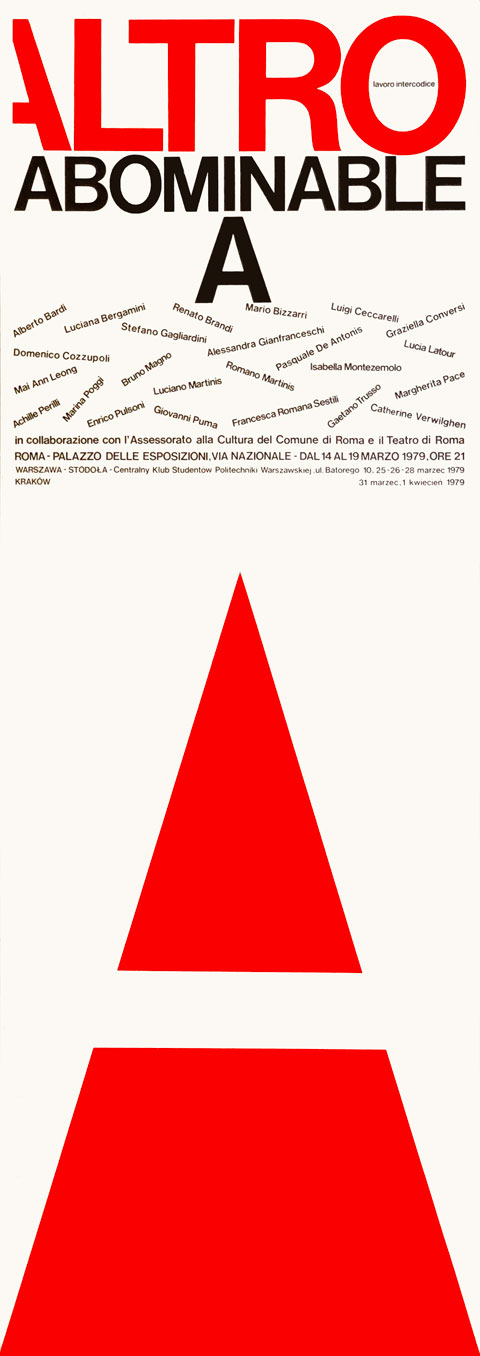
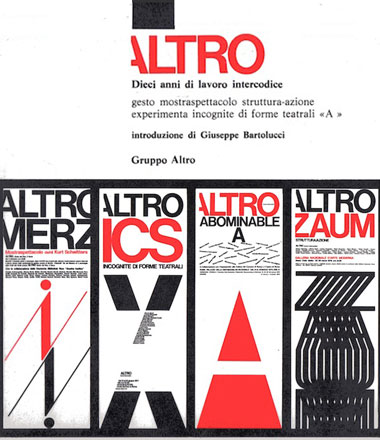
Gruppo ALTRO.
ALTRO 10 anni di lavoro intercodice
Kappa editions, Roma 1981
Architecture / theater materials series.
.
.
This book is collectively signed “Other – intercoded work”
Luigi Ceccarelli was part of the Altro-lavoro intercodice group from 1977 to 1981, the year of the realization of this text and the year in which the original group actually dissolved becoming “Altroteatro”.
Abominable A – Anagramma
Fugue for four dialogues with 9-voices
the score is performed by nine actors. The text, elaborated collectively starting from single words, was considered as a two-voice dialogue.
The final score uses dialogue fragments to generate a canon structure.
[wpdm_file id=67 desc=”true”]
In the “Intercode scheme” the actions-words that form the structure of the show, their sequence, the complexity of the intercode materials are represented. The representation is determined by the “presence or absence” of the materials.
Sound – the presence of sound and its spatial position are indicated.
Visual – the presence of projections is indicated
Space – the positions of the actors in the various situations and the directions of movement were indicated.
Movement – we wanted to indicate the movement of the actors and machineries (alone or together)
Light – the moment of switching on of the side projectors (films, slides) on the two sides (A and B) is indicated in addition to the theatrical lights.
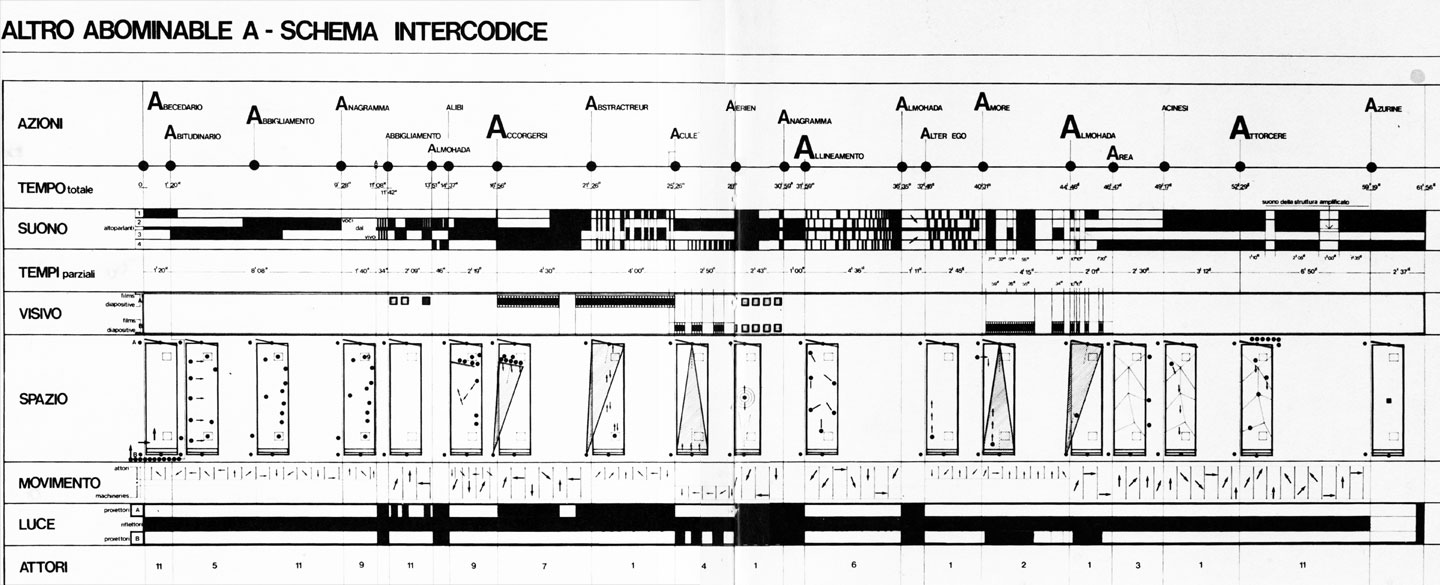
[wpdm_file id=68]
Stage and audience amplification scheme
Design of the mobile speakers placed above the spectators.
Four contact microphones amplified a metal structure operated by the performers.


